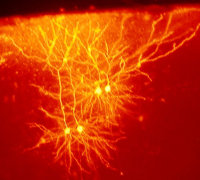If you are frequently procrastinating at work by watching YouTube videos, you might be familiar with this one (It's not very new, but I learned about it only recently):
Amazing, right? The study to which the video refers was quite big news: Chimps outperform humans in a working memory task!
But, although it's a cool video, these reports were overly enthusiastic. I'm sure you've spotted a few huge confounds in the comparison between the humans and the chimp. First, the celebrity chimp was selected based on his excellent performance on this particular task. So, who knows, he might be an idiot savant? But a far more serious concern is the amount of practice that the chimp received. According to the supplementary data, the chimp's practice consisted of four sessions a day, 5 to 6 six days a week. The humans' practice routine doesn't appear to be specified, but according to the criticism by Silberberg and Kearns they received no practice at all.
At any rate, even if the humans received some practice, we may safely assume that they were not trained as extensively as the chimp. So the obvious question is what happens if humans are heavily trained. And the unspectacular answer is that they become just as good as the chimp. So, did chimps beat humans at this memory task? Yes, because they practiced...
References
Inoue, S., & Matsuzawa, T. (2007). Working memory of numerals in chimpanzees. Current Biology, 17(23), R1004-R1005. doi:10.1016/j.cub.2007.10.027 …






 The book starts out lightly, describing
fairly innocuous cases of bad science. For example,
The book starts out lightly, describing
fairly innocuous cases of bad science. For example,